Float flying’s summer splash
Severe clear reigns for Greenville, Maine’s fly-in
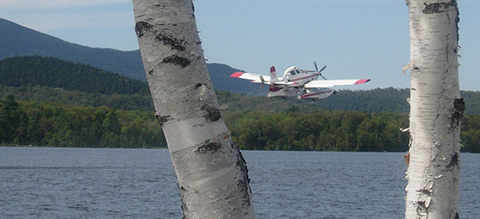
Bob Welch climbs down from his Cessna Skylark amphibious floatplane to direct the crew that has materialized from a crowd of spectators to help maneuver his airplane into a parking spot.
Even on a ramp filling up with wondrous winged watercraft, Welch’s beautiful airplane, with its moose-themed art painted on surfaces from the tail to paddles tucked into the floats, stands out.
Skywhat? Cessna 175 meets moose
Amphib is a conversion of a variant
By Dan Namowitz
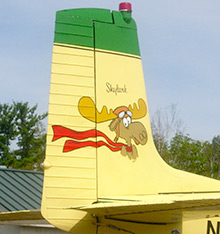
Wait a minute, that’s not a Skyhawk.
It sure looks like an older Cessna 172—a beautiful one at that, adorned with bush-pilot-appropriate artwork painted by Greenville, Maine, sign maker Gary Caron, who has painted Dumbo the Elephant on a DC-3 and emblazoned an Alaska flying service's aircraft fleet with horned white horses.
But it says Skylark, not Skyhawk, above the scarved-and-goggled moose painted on the vertical tail of the Cessna. The airplane is further transformed into an eye-catching amphib by a pair of hefty Baumann 1550A floats.
This straight-tailed Cessna is a model 175, a variant of the Cessna 172 that was produced for about four years starting in 1958. The Skylark had a 175-horsepower geared Continental engine that required pilots to keep two separate performance values in mind: engine revs and propeller rpm. A sharp-eyed observer can pick a Skylark out of a flock of Skyhawks by spotting the bump in the 175’s cowling that accommodated the geared Continental engine.
Now the mystery deepens. This airplane’s cowling has no bump.
Bob Welch, the airplane’s owner, confirmed that his airplane is a 1958 Skylark. There’s no bump on the cowling because his airplane has been converted and upgraded with a 180-hp Lycoming O-360 engine.
Skyhawk-family aircraft on amphibious floats tend to surrender so much useful load that they essentially become two-seat aircraft, Welch said. The conversion brought his Skylark back up to being a four-seater again, restoring useful load to about 1,000 pounds.
It’s an understatement, obviously, to say that this gleaming and unusual aircraft is Welch’s pride and joy. That’s especially so, he tells you, because he didn’t come to own it through perk or privilege.
“I’m just a guy who got up and went to work every day,” he said.
How’s performance?
“When on the water, it’s a boat,” Welch said. “When you’re in the air, it’s still a boat.”
Why all the moose?
“Moose River, Moose Mountain, Moosehead Lake,” he answers.
It’s Friday morning, Sept. 9, the first full day of the 2011 International Seaplane Fly-in on Moosehead Lake in Greenville, Maine. Big Moose Mountain rises above the scene to the west, and Welch has just arrived from his base on the nearby Moose River.
Consecutive downpours from the recently expired Hurricane Irene and tropical storms named Katia and Lee have finally passed. The sun is out, and a brisk breeze stirs the lake. The forecast is nothing short of spectacular. It’s starting to look like a lot of people have made a last-minute decision to show up in Greenville.
The first wave of burgers and dogs has barely hit the grill, and already the crowd wanders among the aircraft or seeks out good spots to unfold lawn chairs and watch the flying.
Inside the Maine Department of Inland Fisheries and Wildlife’s Stobie hangar, organizations from the Seaplane Pilots Association and the Recreational Aviation Foundation to Avitat, the FBO at nearby Bangor International Airport, and vendors are setting up shop.
There’s a sudden roar. Everyone looks up.
“Here comes the fire boss,” says a voice in the crowd.
An Air Tractor on floats passes low over the lake, dropping a load of water from its hopper. The cloud of droplets seems to hang for a moment before falling to the water below like a dissipating tornado.
Welch plans to be part of Saturday’s competition of bomb drops, spot landings, canoe races, and so forth. “We’re out to sweep this year,” he vows.
He also likes to watch the goings-on, and he plans to catch a shuttle ride up to the Greenville Municipal Airport to see what aircraft will be on display there during a full weekend of float-flying fun.
“It’s not an airshow, it’s not a fly-in. You can call it a bush pilot’s rodeo,” he says of the event.
Jane and Steve Reep and their dog, Tracy, are already sunning in great spots on the grass for watching the splashdowns, takeoffs, and flybys. They have driven up in their motor home from Gilford, N.H. Reep is wearing a T-shirt that says “Go to Hull” on the front.
Where’s Hull?
“On the bottom of a Lake amphibian,” he replies.
Of course...
Reep, a retired Eastern Airlines pilot, instructs on floats on Lake Winnisquam in Laconia, N.H. Hinting at the kind of aircraft he used to fly for the airline, he remarks that a DC-9 that once landed at the Laconia airport was of unusual size for the field but still “just a bizjet.”
Now that his T-shirt has passed inspection, Reep inquires as to whether his hat might be of interest—specifically the emblem. It says UFO.
Cute.
No, he says, look closer.
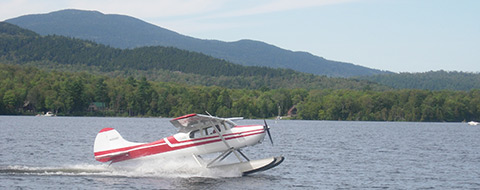
“United Flying Octogenarians.”
Reep vigorously denies that he swiped some old fellow’s hat—even claiming that he has had the right to wear the UFO emblem for more than just a little while.
Perhaps, but people say and do some outrageous things in this crowd.
Gene Fournier is sitting nearby, just soaking it all up. Now he gives a wave and a smile. AOPA readers will be familiar with the writings of Fournier’s older brother, Paul. Falling into conversation with Fournier is one of the easiest things a person can do. It doesn’t matter how long it’s been since last time. He just picks up the story from that point, and it’s always worth hearing. If there were a float-flying event in Maine without Fournier present, a lot of people would fret that they had landed at the wrong lake.
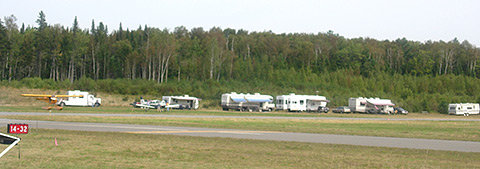
Arrivals keep coming in, and departures keep rolling down the ramp and into the water. Conducting this symphony of many movements on an ever-more crowded ramp is a sort of Leonard Bernstein of the Lake. His name is Dan Hughes, and he proffers his propensity for partitioning people from pontoons and propellers “as a citizen of Greenville,” he says during a lull.
On the lake, the Katahdin, a 1914-vintage steamboat owned by the Moosehead Marine Museum, threads its way out among the watercraft for a lake tour. The boat is a floating piece of history, built on the Maine coast at Bath Iron Works, where they still turn out the big ones.
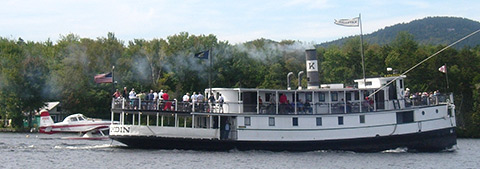
If you think there’s a lot of activity going on outside, step into the hangar and track down Steve McCaughey, who took over as executive director of the Seaplane Pilots Association only on July 15.
He’s the red-headed guy over there talking on his cellphone, posting a message on a website, and shaking hands with a prospective new SPA member, all simultaneously.
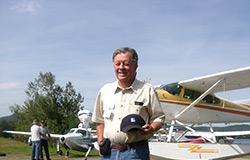 Dave Quam, the founder of the SPA and the fly-in
Dave Quam, the founder of the SPA and the fly-in
This is McCaughey’s first time at the Greenville fly-in, and he has just been invited by Mary Build of Naples Seaplanes to go flying on a poker run. He’s also trying to figure out where to hang up some SPA banners around the grounds.
Meanwhile, Dave Quam, who founded the SPA and started the fly-in event in 1973 at the urging of some Greenville pilots was on hand for the event. A Minnesotan, Quam got his float training on the Hackensack River in Little Ferry, N.J., while working for a media company in New York City. What originated as an effort to organize and publish information of interest to seaplane pilots has grown into an organization that now boasts more than 7,000 members. “We had a card table and a file cabinet, and that was it,” he said.
Back outside in the sun and the wind, Welch is spoiling for a fight.
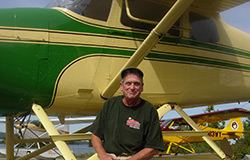 Bob Welch and his amphibious Cessna Skylark are ready to compete
Bob Welch and his amphibious Cessna Skylark are ready to compete
Last year he came in second in the bomb-drop competition. He’s been practicing ever since with a hundred-pound bag of potatoes to get back on top.
Welch says he didn’t let last year’s results get him down—not even a close call on a spot landing. However, it would be a stretch to say that he has moved on from the defeat.
“It is better to lose with controversy than to win cleanly,” he says.



